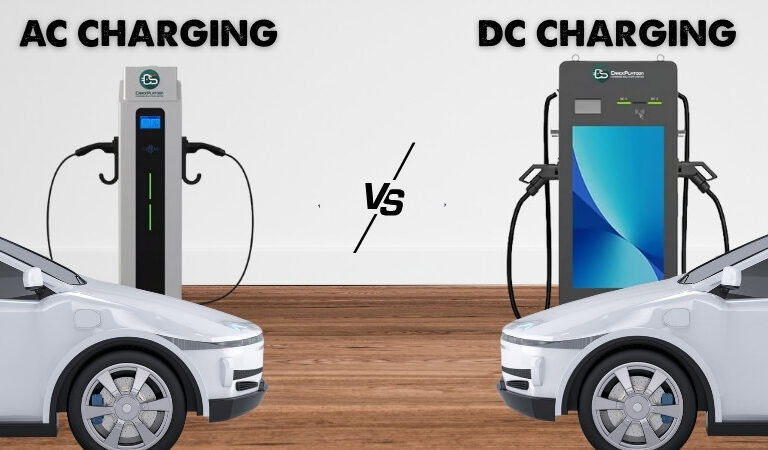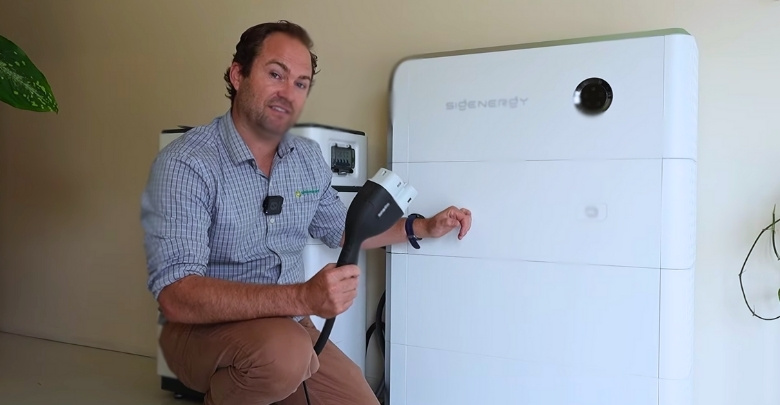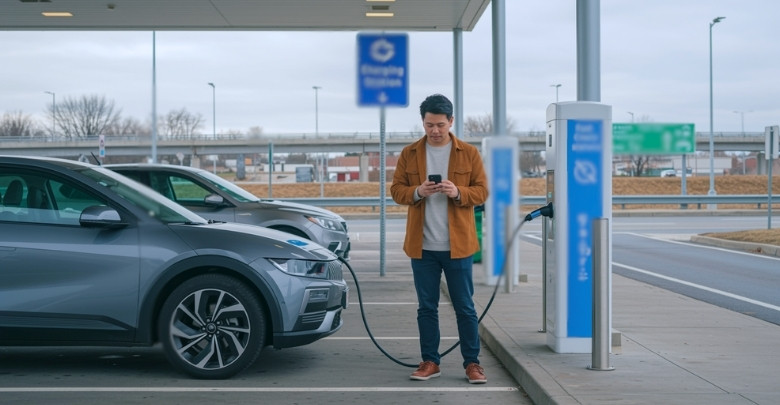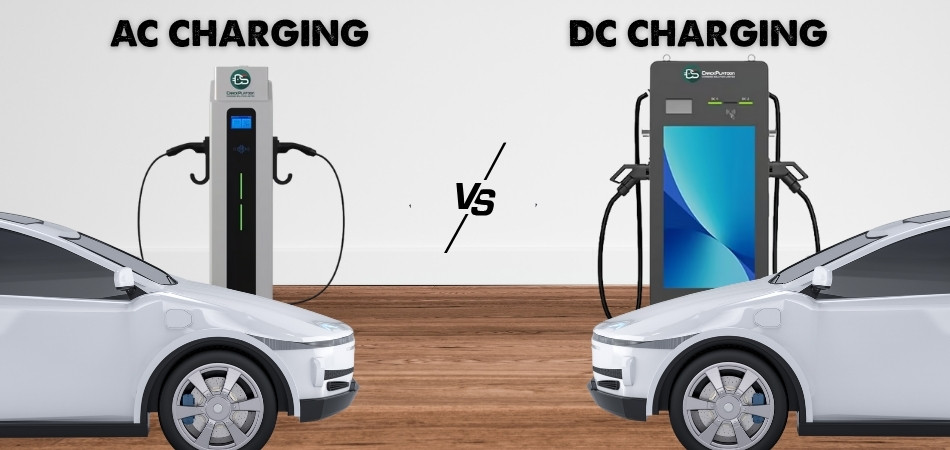Charging electric vehicles has become a daily task for many drivers, whether at home or on the go. Some charge slowly while others power up fast, and this depends on more than just the charger brand. That’s why many people want to understand the difference between AC and DC charging for electric vehicles and how it affects their charging experience.
The main difference between AC and DC charging is the power conversion location. AC charging is slower, cheaper, and better for battery life. DC charging is faster, costlier, and suited for quick top-ups. Choose AC for home and DC for long trips.
Are you curious about when to use AC or DC chargers, or how they affect battery life and travel time? Keep reading this article because you’ll find every important detail explained clearly, from charging speed and cost to the kind of equipment each one needs.
Difference Between AC and DC Charging for Electric Vehicles
Electric car charging isn’t one-size-fits-all—it depends a lot on the kind of power source being used. AC and DC charging both come with different speeds, costs, and setups. Let’s go over how they compare and what you should know.

Power Conversion
Electric vehicles run on DC power, but not all chargers deliver that directly. With AC charging, the electricity is converted inside the car by a built-in charger. DC charging does the job at the station itself, which is why it sends power to your battery much faster. This difference in where the conversion happens plays a big role in how long your car takes to charge.
Charging Speed
If you’ve ever wondered why your EV charges slowly at home, it’s probably using an AC charger. Basic AC chargers might only give you 3–5 miles of range per hour, while a good Level 2 one can do 10–60 miles per hour. DC chargers skip the slow process and can power up your battery to 80% in just 30 minutes or less, which is perfect when you’re in a hurry.
Setup and Installation
You don’t need anything too fancy for AC charging at home. It’s cheaper, easier to set up, and doesn’t take up much space. You often see DC charging in commercial spots because it requires more power and a more complex setup. With more people charging at home, AC chargers are becoming popular in countries like Bangladesh. That’s also why EV charging stations in Bangladesh mostly begin with AC options before shifting to faster DC ones.
Battery Effects
Every time your battery gets charged, it heats up a little. AC charging is slower and puts less strain on the battery, which can help it last longer. DC charging is much faster, but that speed builds up heat and could wear out the battery quicker over time. If you’re charging overnight at home, it’s often better to use AC and save DC for quick stops during the day.
Where It’s Found
Most homes and office buildings stick to AC charging because it’s easier to install and doesn’t cost as much. DC chargers are bigger and require more power, so you’ll find them more often on highways, shopping centers, and EV charging hubs. That difference in where each charger is placed makes it helpful to plan your routes if you’re driving long distances.
Size and Portability
AC chargers are usually smaller and can sometimes be unplugged and moved if needed. They’re designed for simple setups like garages or parking spots. DC chargers are large machines meant to stay in one place, mostly used in commercial areas. You won’t find people setting up DC units in their homes due to space and cost reasons.
Charging Cost
If you care about keeping your electric bill low, AC charging is a better bet. It takes more time but costs less in most cases. DC chargers use a lot of electricity quickly and often charge more per session. Some public DC stations also include extra service fees, which can make regular use a bit expensive compared to slow, steady AC charging at home.
Both AC and DC charging are useful in different ways depending on your needs. AC is great for regular home use, while DC is better when you need fast charging on the go. Knowing the difference helps you save time, money, and protect your battery. Always pick the option that fits your daily routine and travel plans best.
How to Identify Whether an EV Charger Is AC or DC?
Figuring out if an EV charger is AC or DC might sound confusing at first. But once you know what to look for, it gets easier. Both types work differently and are made for different charging needs. Let’s break it down clearly.
Charging Speed
One way to tell is by how fast the charger works. AC chargers usually take longer to charge a car. They’re common at home and in places like malls. DC chargers, on the other hand, are much faster and are found at highway rest stops. If the charger fills up the battery in under an hour, it’s likely a DC charger.
Plug Type
Different chargers come with different plugs. AC chargers often have smaller, rounder connectors, while DC chargers have larger, heavier ones with more pins. If you see a bulky plug that looks strong and solid, it’s probably meant for DC charging. The plug design is one of the easiest clues to notice.
Charger Location
Where the charger is placed can also give you a hint. AC chargers are mostly installed at homes, offices, or places where people park for a long time. DC chargers are placed in spots where fast charging is needed, like gas stations or highway rest areas. So, the place can tell you a lot.
Charging Label
Sometimes, the charger itself has a label or sign that says if it’s AC or DC. Look for tags like “Level 2” for AC or “DC fast charger” for DC. These labels are usually found near the charging cable or on the front panel. A quick look might give you the answer right away.
Charger Size
DC chargers are bigger and often come with a box-like machine beside them. They need more cooling, so they look like they have fans or vents. AC chargers are smaller and often mounted on a wall or post. If it looks large and powerful, you’re likely looking at a DC charger.
That’s a simple way to spot the difference between AC and DC chargers. If you’re curious to learn more about how each charger works and which one suits your car, there’s more to explore ahead.
What Equipment Is Needed for AC and DC EV Charging?
Not all EV chargers need the same tools to work. Some need extra parts depending on how fast they charge or where they are placed. The equipment also changes between home use and public stations. Keep reading to see what each setup usually includes.

Charging Cable
Every charger needs a cable that connects the car to the power source. For AC charging, this cable is usually lighter and thinner. DC chargers use thicker cables since they carry more power. These cables are built to handle high voltage and heat. You’ll usually find the cable already attached to public DC chargers, while AC ones might require you to bring your own.
Power Supply Unit
Each system runs on a different power setup. AC chargers work with standard home electricity, but they may need a 240-volt outlet. DC chargers use special high-power connections that often need a separate unit for power delivery. This setup helps handle faster charging and stronger currents. Without the right supply, the charger won’t work safely or properly.
Plug and Socket
To connect the charger to your EV, you need the right plug. There are different types of plugs based on car models and charger types. AC chargers often use Type 1 or Type 2 connectors, while DC chargers might use CCS or CHAdeMO. It’s important that the plug and socket match properly, or else the charging can’t start.
Communication System
There’s more to charging than just plugging in. Beyond cables and connectors, some charging systems also rely on protocols that follow specific EV charging communication standards to ensure proper data exchange between the car and charger. This helps the charger understand how much power the car needs and when to stop charging. It keeps the whole process smooth and safe.
Cooling and Safety
While AC chargers usually don’t need cooling, many DC chargers do. They come with built-in fans or liquid cooling to stop overheating. Both AC and DC systems also need safety tools like circuit breakers, grounding wires, and sometimes surge protectors. These make sure that charging doesn’t damage the car or cause any kind of short circuit.
Understanding what equipment is used for EV charging helps make the process feel simpler. Each piece plays a role in keeping charging fast, safe, and smooth. Whether it’s AC or DC, the right tools matter. There’s still more to learn about how all these parts work together.
Can All EVs Use Both AC and DC Charging Options?
Some electric cars charge faster than others, and part of that depends on how they handle AC and DC power. Not every vehicle works with both types of chargers. It all comes down to design and support. Let’s dive into the details to clear it up.
AC Charging Basics
All electric cars can handle AC charging because they come with an onboard charger. This built-in part turns AC power from your wall outlet into the kind of power the battery can store. Most AC charging happens at home or at places like parking lots. It’s slower than DC charging, but it works with every EV. Whether it’s a small car or an SUV, AC charging is always an option.
DC Charging Limits
Unlike AC, not every electric car is ready for DC fast charging. Some models don’t support it at all, while others offer it only in certain versions. DC chargers skip the car’s onboard system and send power straight to the battery. This helps charge the battery much faster. Still, you need to check if your vehicle can accept that kind of charge safely.
Charging Port Types
Different EVs come with different charging ports. Some use a single port for both AC and DC, like the CCS system. Others, like cars from Japan, might use CHAdeMO for fast charging and a separate one for AC. Tesla uses its own kind called NACS, but it also supports other types with adapters. You’ll always need to match the plug with the port.
What to Check
Before using a DC charger, it’s important to check your car’s manual or charging guide. Some cars may look like they support fast charging but actually don’t. The model, year, and even the country where it was sold can make a difference. It’s better to know these things early, so you don’t face issues when trying to charge quickly.
Charging Flexibility
Some EVs give you more choices when it comes to charging. They support both AC and DC, so you can charge anywhere. This is useful when you’re away from home or short on time. Other EVs are better suited for slower home charging. The more charging options your car supports, the easier it is to keep going without stress.
Now that you know the basics, it’s easier to understand how EVs connect to chargers. Always look at your car’s features before trying fast charging. The better you know your options, the smoother your charging will be.
Which Charging Type Is Better for Long-Distance Travel?
Long trips in an electric car need more planning than short drives. One of the biggest things to think about is how and where you’ll charge. Not every type of charger is right for long-distance travel. Let’s look at the details to help decide.

Charging Time
Fast charging can save hours when you’re far from home. Most people don’t want to wait too long on the road, and that’s where DC charging becomes useful. It can charge a car’s battery up to 80% in around 30 minutes. That kind of speed makes it easier to stop briefly, grab a snack, and continue the trip without wasting time.
Station Availability
Public charging stations aren’t all the same, and their locations matter a lot. Highways and busy roads often have DC fast chargers placed at regular spots. You’ll still find AC chargers too, but they’re mostly in places meant for long stops, like hotels. For road trips or intercity driving, many drivers choose DC stations because of the speed and convenience, two key benefits of DC charging in EV travel scenarios.
Battery Size Match
Electric cars come with different battery sizes, and that affects which charger works best. Bigger batteries need stronger chargers to fill up faster. On long trips, smaller batteries might not last between distant stations if only AC charging is used. That’s why using a fast charger can really help, especially if your EV has a large battery that takes longer to fill.
Cost and Planning
Quick charging usually costs more than slow charging. But when you’re traveling far, the extra cost might be worth it. You can save time and get back on the road quickly. If your trip is long and you’re in a hurry, planning your stops around fast-charging stations is the smart move, even if the price is a bit higher.
Charging Comfort
Some people choose where to charge based on nearby services. Fast chargers are often placed near restaurants, restrooms, or stores, making the break more comfortable. AC chargers can be found in quieter places, but they need more time. When you’re covering a lot of distance, being able to charge fast and enjoy a short break is more helpful.
Choosing between AC and DC charging really depends on how far you’re going and how fast you want to move. DC charging is great for long trips because it saves time. AC works better when you’re not in a rush. Knowing when to use each one makes traveling much easier.
FAQs About the Difference Between AC and DC Charging for Electric Vehicles
Still have questions about how AC and DC charging really work for EVs? This FAQ dives into the most common concerns and clears up what each type of charging means in everyday use. From charging speed to practical use cases, you’ll find straightforward answers right here.
How Does Weather Affect EV Charging?
The weather can change how fast your EV charges. In cold temperatures, charging slows down because the battery doesn’t work as well. Extremely hot weather can also cause delays or even reduce charging power to protect the battery. That’s why EVs sometimes charge faster in mild weather than during extreme conditions.
Can You Switch Between AC and DC Charging?
Yes, you can switch between them if your car supports both. Some people charge with AC at home and use DC fast chargers while traveling. The car will detect the charger type and adjust automatically. Just make sure the charger plug matches your car’s charging port.
Does Charging Type Affect Driving Range?
The type of charger doesn’t change how far your car can go once fully charged. However, fast charging with DC gets you back on the road sooner. AC chargers take longer but still give you the same battery range. The main difference is how quickly you reach full charge, not how far you can drive.
Is One Charging Type Safer Than the Other?
Both types are built to be safe, but each has different needs. DC chargers often come with extra cooling and safety tools because they use more power. AC chargers are usually simpler and safer to use at home. No matter which type, always follow the charger’s safety instructions.
Can Charging Stations Run Out of Power?
It’s rare, but yes, some public charging stations can run into power issues. This may happen if many cars are charging at the same time or if there’s a power cut in the area. Good stations have backup systems or alerts when something goes wrong. It’s always a good idea to check the charger status before you go.
Do All Public Chargers Work with All EVs?
Not always. Some chargers might use a plug that doesn’t match your car. It’s important to check if your EV is compatible with the charger’s connector type. Many apps or websites show which chargers work with your car model, so you can avoid problems.
Can You Install DC Chargers at Home?
In most cases, no. DC chargers need more power and special equipment that’s too expensive and large for home use. They’re meant for places like gas stations or shopping centers. Home users usually stick with AC chargers because they’re smaller, cheaper, and easier to install.
Does Charging Too Often Harm the Battery?
Charging often with AC doesn’t really harm your battery if done correctly. DC fast charging too often might heat the battery more, which can reduce its life over time. That’s why many people use AC for daily charging and save DC for trips. Battery care depends on how often and how fast you charge.
Are Charging Times Always the Same?
Charging times can change based on battery size, power level, and charger type. Even the weather and battery temperature can affect speed. Sometimes, a charger might slow down near the end to protect the battery. So even if you’ve used a charger before, the time might not always be exactly the same.
What Happens If You Stop Charging Midway?
If you stop charging before it’s full, it won’t harm the battery. Most EVs let you unplug at any time, and the car will save whatever power it has. This is helpful if you’re in a hurry or the charger is busy. You can always finish charging later without causing damage.
Last Words
Both AC and DC charging are important in their own way, depending on where and how you plan to charge. AC works best at home with slower charging, while DC helps during trips when you need power quickly. So now you know the difference between AC and DC charging for electric vehicles in simple terms—AC is steady and home-friendly, while DC is fast and travel-ready.
To make charging easier, always check if your car supports both types, carry the right plug or adapter, and plan ahead for long drives. Choose AC when you have time and DC when you’re in a rush. Stay safe, enjoy the ride, and all the best with your EV charging experience!

